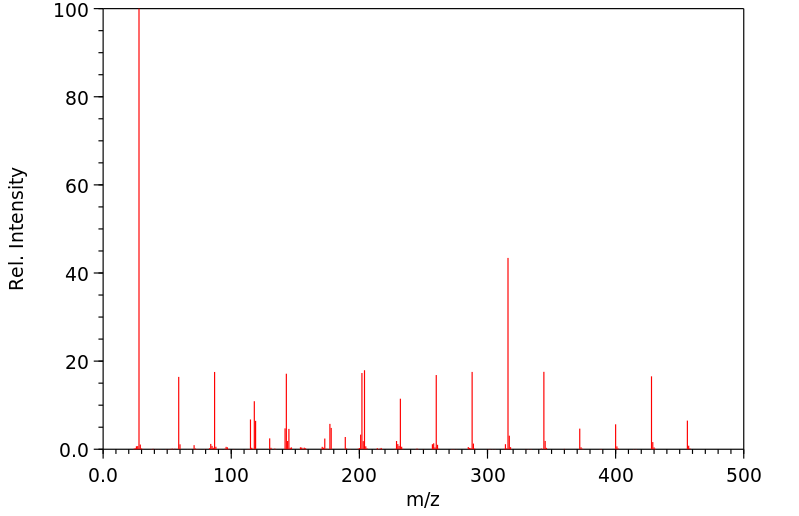methylidynetricobalt(I)nonacarbonyl
中文名称
——
中文别名
——
英文名称
methylidynetricobalt(I)nonacarbonyl
英文别名
μ-ethylidene-nona(carbonyl)-tri(cobalt);methylidynetricobalt nanocarbonyl;ethylidyne tricobalt nonacarbonyl
CAS
——
化学式
C11H3Co3O9
mdl
——
分子量
456.119
InChiKey
KKHPMWJWWUDZES-UHFFFAOYSA-N
BEILSTEIN
——
EINECS
——
-
物化性质
-
计算性质
-
ADMET
-
安全信息
-
SDS
-
制备方法与用途
-
上下游信息
-
文献信息
-
表征谱图
-
同类化合物
-
相关功能分类
-
相关结构分类
计算性质
-
辛醇/水分配系数(LogP):None
-
重原子数:None
-
可旋转键数:None
-
环数:None
-
sp3杂化的碳原子比例:None
-
拓扑面积:None
-
氢给体数:None
-
氢受体数:None
反应信息
-
作为反应物:描述:参考文献:名称:Gmelin Handbuch der Anorganischen Chemie, Gmelin Handbook: Co: Org.Verb.2, 3.1.3.5, page 152 - 167摘要:DOI:
-
作为产物:描述:(acetylene)hexacarbonyldicobalt 以 not given 为溶剂, 以49%的产率得到methylidynetricobalt(I)nonacarbonyl参考文献:名称:The Association of an Acetylene with Three Metal Atoms; A New Trinuclear Cobalt Complex摘要:DOI:10.1021/ja01557a018
文献信息
-
Chemistry of methinyltricobalt enneacarbonyls. Part V. Tertiary phosphine and arsine derivatives作者:T. W. Matheson、B. H. Robinson、W. S. ThamDOI:10.1039/j19710001457日期:——Mono-, di-, and tri-substituted tertiary phosphine and arsine derivatives of methinyltricobalt enneacarbonyls have been prepared. The co-ordination behaviour of the cluster is determined by the apical substituent Y, and the stereochemistry adopted is one which minimizes nonbonded carbonyl interactions. Thus the majority of mono-substituted complexes have the same structure as MeCCo3(CO)8Ph3P but other
-
Reactions of diarsines with bi- and tri-metallic carbonyl complexes containing cobalt作者:Nick Choi、Gráinne Conole、Jason D. King、Martin J. Mays、Mary McPartlin、Caroline L. StoneDOI:10.1039/a906611j日期:——Reaction of the diarsines As2R4 (R = Me or Ph) with alkyne-bridged dicobalt hexacarbonyl complexes leads to products with bridging (AsR2)2O ligands and to the production of simple AsR3 substituted complexes; alkylidyne tricobalt nonacarbonyl complexes exhibit parallel reactivity with As2R4. Thermolysis of the complex [Co2(μ-PhCCPh)μ-(AsMe2)2O}(CO)4] gives the tetra-substituted complex, [Co2(μ-PhCCPh)μ-(AsMe2)2O}2(CO)2]. Reaction of the heterometallic complex [(OC)3Coμ-C2(CO2Me)2}MoCp(CO)2] with As2Ph4 affords [(HO)Ph2As}(OC)2Coμ-C2(CO2Me)2}MoCp(CO)2], supporting the suggestion of a possible hydrolytic mechanism for the formation of the (AsR2)2O bridged complexes.
-
Phosphorus–oxygen bond formation on organo-capped tricobalt centres via phosphorus–hydrogen or phosphorus–phosphorus bond scission作者:Gillian A. Acum、Martin J. Mays、Paul R. Raithby、Harold R. Powell、Gregory A. SolanDOI:10.1039/a702669b日期:——Chromatographic work-up of the initial products of the reaction of the secondary phosphine PPh2H with [Co3(µ3-CR)(CO)9] (R = Me 1a or CO2Me 1b) at 308 K in heptane gave the mono- and bis-substituted complexes [Co3(µ3-CR)(CO)8(PPh2H)] (R = Me 2a or CO2Me 2b) and [Co3(µ3-CR)(CO)7(PPh2H)2] (R  Me 3a or CO2Me 3b) and, in addition, when R = Me, the complex [Co3(µ3-CMe)(µ-Ph2POPPh2)(CO)6(PPh2H)] 4a, in which phosphorusâoxygen bond formation has occurred. Thermolysis of complex 2a at 343 K in heptane gave 1a and [Co3(µ3-CMe)(µ-H)(µ-PPh2)(CO)7] 5a, while thermolysis of 3a under the same conditions afforded 4a, a trace of 5a and [Co3(µ3-CMe)(µ-H)(µ-PPh2)(CO)6(PPh2H)] 6a. Similar reactions with the µ3-CCO2Me capped species 2b and 3b resulted in unstable non-isolable species. Treatment of complexes 3a, 3b with CO at 343 K causes the replacement of first one and then the other PPh2H ligand by CO to give 2a, 2b and then 1a, 1b respectively, while reformation of a phosphorusâhydrogen bond to give initially 2a or 3a can be achieved on carbonylation of either complex 5a or 6a. Substitution of a PPh2H group in 4a can be achieved by purging with CO to give [Co3(µ3-CMe)(µ-Ph2POPPh2)(CO)7] 7a. Complex 7a can also be prepared directly by the reaction of 1a with the diphosphane P2Ph4 as can the analogue [Co3(µ3-CCO2Me)(µ-Ph2POPPh2)(CO)7] 7b on reaction of 1b. The intermediates [Co3(µ3-CR)(CO)8(P2Ph4)] (R = Me 8a or CO2Me 8b) and [Co3(µ3-CR)(µ-P2Ph4)(CO)7] (R = Me 9a or CO2Me 9b) isolated in the reactions can be converted under the same reaction conditions into 7a and 7b respectively. Complex [Co3(µ3-CMe)(µ-Ph2POPPh2)(CO)6(PPhMe2)] 4aâ², the tertiary phosphine analogue of 4a, has been prepared from the reaction of 7a with PPhMe2. The structures of complexes 4aâ² and 5a have been determined by single crystal X-ray diffraction studies.在308 K的庚烷中,二次膦PPh2H与[Co3(µ3-CR)(CO)9](R = Me 1a或CO2Me 1b)反应的初始产物经色谱处理后得到单取代和双取代的配合物[Co3(µ3-CR)(CO)8(PPh2H)](R = Me 2a或CO2Me 2b)和[Co3(µ3-CR)(CO)7(PPh2H)2](R = Me 3a或CO2Me 3b),此外,当R = Me时,还得到了配合物[Co3(µ3-CMe)(µ-Ph2POPPh2)(CO)6(PPh2H)] 4a,其中发生了磷-氧键的形成。在343 K的庚烷中热分解配合物2a得到了1a和[Co3(µ3-CMe)(µ-H)(µ-PPh2)(CO)7] 5a,而相同条件下热分解3a得到了4a、少量的5a和[Co3(µ3-CMe)(µ-H)(µ-PPh2)(CO)6(PPh2H)] 6a。与µ3-CCO2Me封端的物种2b和3b类似的反应产生了不稳定的非可分离物种。在343 K下用CO处理配合物3a, 3b会导致PPh2H配体被CO逐步替换,分别先得到2a, 2b,然后得到1a, 1b,而在配合物5a或6a的羰基化过程中可以重新形成磷-氢键,最初得到2a或3a。通过用CO吹扫可以实现4a中PPh2H基团的取代,得到[Co3(µ3-CMe)(µ-Ph2POPPh2)(CO)7] 7a。配合物7a也可以通过1a与二膦P2Ph4的反应直接制备,类似地,通过1b的反应可以制备出相似的[Co3(µ3-CCO2Me)(µ-Ph2POPPh2)(CO)7] 7b。在反应中分离得到的中间体[Co3(µ3-CR)(CO)8(P2Ph4)](R = Me 8a或CO2Me 8b)和[Co3(µ3-CR)(µ-P2Ph4)(CO)7](R = Me 9a或CO2Me 9b)可以在相同的反应条件下分别转化为7a和7b。通过7a与PPhMe2的反应,已经制备出了配合物[Co3(µ3-CMe)(µ-Ph2POPPh2)(CO)6(PPhMe2)] 4a′,即4a的三级膦类似物。通过单晶X射线衍射研究,已经确定了配合物4a′和5a的结构。
-
Studies of metal exchange reactions: the synthesis and structures of heteronuclear metal clusters containing the indenyl ligand (μ3-CR)Co2M(CO)8(η5- Ind)(R=H,CH3,C6H5,COOC2H5; M=Mo,W)作者:Wei-Qiang Zhang、Bao-Hua Zhu、Bin Hu、Yu-Hua Zhang、Quan-Yi Zhao、Yuan-Qi Yin、Jie SunDOI:10.1016/j.jorganchem.2003.11.028日期:2004.2The novel tetrahedral clusters (μ3-CR)Co2M(CO)8(η5-Ind) (M=Mo,W; R=H, CH3, C6H5, COOC2H5) 5–12 containing the indenyl ligand were isolated from reactions of tricobalt clusters (μ3-CR)Co3(CO)9 (R=H, CH3, C6H5, COOC2H5) and K(η5-Ind)M(CO)3 (M=Mo,W) under mild conditions. The cluster complex (μ3-CC6H5)CoMo2(CO)7(η5-Ind)(η5-Cp (Cp*=C5H4C(O)CH3) 16 was obtained via the stepwise metal exchange reaction of新颖的四面体簇(μ 3 -CR)有限公司2 M(CO)8(η 5 -Ind)(M =钼,钨; R = H,CH 3,C 6 H ^ 5,COOC 2 H ^ 5)5 - 12含茚基配位体是从(μ三钴簇的反应中分离3 -CR)有限公司3(CO)9(R = H,CH 3,C 6 H ^ 5,COOC 2 H ^ 5)和K(η 5 -Ind)M (CO)3(M = Mo,W)在温和条件下。簇络合物(μ 3 -CC 6 ħ 5)的CoMo 2(CO)7(η 5 -Ind)(η 5 -CP(CP * = C 5 H ^ 4(O)CH 2 C 6 3)16经由逐步得到络合物(μ的金属交换反应3 -CC 6 ħ 5)有限2的Mo(CO)8(η 5 -Ind)9用Na(η 5 -CPMo(CO)3,但其中反应(μ 3 -CC 6高5)有限公司2的Mo(CO)8(η 5 -CP *)15与K(η 5 -In
-
Formation of novel chelating phosphine ligands via the reaction of [WCC<sub>6</sub>H<sub>4</sub>Me-4(CO)<sub>2</sub>(η-C<sub>5</sub>H<sub>5</sub>)] with the bidentate phosphine C<sub>6</sub>H<sub>4</sub>(PH<sub>2</sub>)<sub>2</sub>-1,2; X-ray crystal structures of the complexes [W{σ,η<sup>3</sup>-C<sub>6</sub>H<sub>4</sub>(PH<sub>2</sub>)(PC{OH}CH{C<sub>6</sub>H<sub>4</sub>Me-4})-1,2}(CO)(η-C<sub>5</sub>H<sub>5</sub>)], [{Wl{C<sub>6</sub>H<sub>4</sub>(PH<sub>2</sub>)(P{Me}C{O}CH<sub>2</sub>{C<sub>6</sub>H<sub>4</sub>Me-4})-1,2}(CO)(η-C<sub>5</sub>H<sub>5</sub>)·(]1/2C<sub>4</sub>H<sub>8</sub>O), and [WCo<sub>3</sub>(µ<sub>3</sub>-CR){µ-C<sub>6</sub>H<sub>4</sub>(PH<sub>2</sub>)(PC{OH}CH{C<sub>6</sub>H<sub>4</sub>Me-4})-1,2}(CO)<sub>9</sub>(η-C<sub>5</sub>H<sub>5</sub>)](R = H or Me)作者:James E. Denison、John C. Jeffery、Suanna Harvey、Peter Müller、K. D. Vinindra WeerasuriaDOI:10.1039/c39900001023日期:——Treatment of the mononuclear alkylidyne complex [WCC6H4Me-4(CO)2(η-C5H5)] with one equivalent of the bidentate phosphine C6H4(PH2)2â1,2 affords the metalla-phosphine complex [WÏ,η3-C6H4(PH2)(PCOH}CHC6H4Me-4})-1,2}(CO)(η-C5H5)] which has an unused lone pair of electrons on the central phosphorus atom of the chelate ring and which undergoes P-methylation and, like a conventional PR3 ligand, will substitute CO ligands in transition metal complexes; the structures of the complexes [WÏ,η3-C6H4(PH2)(PCOH}CHC6H4Me-4})-1,2}(CO)(η-C5H5)], [WlC6H4(PH2)(PMe}CO}CH2C6H4Me-4})-1,2}(CO)(η-C5H5)]·(1/2C4H8O), and [WCo3(η3-CR)µ-C6H4(PH2)(PCOH}CHC6H4Me-4})-1,2}(CO)9(η-C5H5)](R = H or Me) have been determined by single crystal X-ray diffraction studies.将单核烷基炔配合物[WC Me-4(CO)2(δ--C5H5)]与一个当量的双齿膦C6H4(PH2)2â1,2进行处理,可得到金属-膦配合物[WÏ,δ-3- (PH2)(PCOH}CH Me-4})-1、2}(CO)(δ-- )],它在螯合环的中心磷原子上有一个未使用的孤对电子,会发生 P-甲基化反应,就像传统的 PR3 配体一样,可以替代过渡金属配合物中的 CO 配体;络合物[WÏ,δ-3- (PH2)(PCOH}CH Me-4})-1,2}(CO)(δ-- )]、[Wl (PH2)(PMe}CO}CH2 Me-4})-1,2}(CO)(δ-- )]Â-(1/2C4H8O)的结构、和[WCo3(δ-3-CR)µ- (PH2)(PCOH}CH Me-4})-1,2}(CO)9(δ-- )](R = H 或 Me)已通过单晶 X 射线衍射研究确定。
表征谱图
-
氢谱1HNMR
-
质谱MS
-
碳谱13CNMR
-
红外IR
-
拉曼Raman
-
峰位数据
-
峰位匹配
-
表征信息
同类化合物
锡杂环戊-3-烯-2,5-二酮
铝,(1,2-二丁基-1-丁烯-1,4-二基)乙基-
过氧化锌
试剂2,8-Diethyl-1,3,5,7-tetramethyl-9-phenylbipyrromethenedifluoroborate
磷英,3-甲基-2-(三甲基甲锡烷基)-
磷杂蒽
磷杂苯
磷杂环戊磷酸
磷杂环戊烷
碳化钙
环戊二烯基(吡咯基)铁
法硼巴坦
氮杂锡杂两面针碱
氧化苯砷
异磷啉
四氧化三铅
八氢[1,2]氮杂硼杂苯并[1,2-a][1,2]氮杂硼杂苯
全氢化-9b-硼杂非那烯
二苯胺氯胂
二氧化铝
[1,2]氮杂硼杂苯并[1,2-a][1,2]氮杂硼杂苯
N,N-二甲基-9-硼杂双环[3.3.1]壬烷-9-胺
B-苄基-9-硼杂双环[3.3.1]壬烷
9-苯基-9-硼杂双环[3.3.1]壬烷
9-磷杂二环[4.2.1]壬烷
9-碘-9-硼杂二环[3.3.1]壬烷
9-硼杂双环[3.3.1]壬烷-9-醇
9-硼双环[3.3.1]壬烷
9-硬脂基-9-磷杂双环[4.2.1]壬烷
9-甲基-10-硝基蒽
9-溴-9-硼杂双环-[3.3.1]壬烷
9-二十烷基-9-磷杂二环[4.2.1]壬烷
9-乙基-9-硼杂双环[3.3.1]壬烷
9-丁基-9-硼杂双环[3.3.1]壬烷
9-(八氢-1-戊搭烯基)-9-磷杂双环[4.2.1]壬烷
9-(1,1,2-三甲基丙氧基)-9-硼双环[3.3.1]壬烷
8-甲氧基-9-硼杂双环[3.3.1]壬烷
5H-二苯并砷唑-5-甲腈
5H,5'H-10,10'-联啡砷
5-羟基-5H-二苯并砷唑 5-氧化物
5-氯-5H-二苯并砷杂环戊二烯
5,10-二氢-10-吩砒嗪乙醇10-硫化物
4,5-二氢-1-甲基-1H-磷杂环戊二烯-2-羧酸 1-氧化物
3-甲基异磷啉
3,5-二苯基膦
2H-咪唑-2-亚基,1,3-二环己基-1,3-二氢-
2-乙基-4,5-二甲基-1,2-氧杂环戊硼烷
2-丙烯酸,3-[3-乙基-2-[2-(3-乙基-4-羰基-2-硫代-5-噻唑烷亚基)亚乙基]-2,3-二氢-6-苯并噻唑基]-
2,4,6-三叔丁基-膦咛
2,4,6-三(苯基)膦咛







